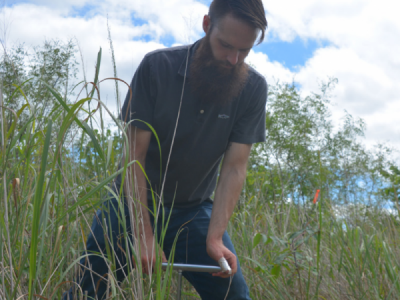
Posted on September 17, 2020
Story by Melanie Peterson
Environmental scientists Aaron McFarlane and Eric Hanson, recently surveyed natural islands in Pool 5, near Fountain City, Wisconsin, and Pool 10, near Guttenberg, Iowa, and man-made islands in Pool 8, near La Crosse, Wisconsin, and Pool 9, near Eastman, Wisconsin, along the Upper Mississippi River.
The man-made islands in pools 8 and 9 were created by the Corps from dredged material. The Corps has several programs for environmental restoration that partner with other federal, state and local partners. One example is the Upper Mississippi River Restoration program, which has constructed restoration projects and conducted long-term monitoring from St. Paul, Minnesota to St. Louis, Missouri, since 1986.
The islands are meant to serve multiple purposes, such as breaking up wind on large expanses of water, providing sheltered areas for vegetation to grow and creating fish and wildlife habitat, McFarlane said.
Over the course of two weeks, the team, including environmental section interns, looked at 45 plots, each 1/100 of an acre. The surveys included identifying each tree and documenting ground cover plants and their density.
Soil sampling consisted of an on-site field description of what the soils looked like. Soil samples were taken and sent to the Engineer and Research Development Center Wetlands and Coastal Ecology lab in Vicksburg, Mississippi to determine physical characteristics and soil chemistry. Small cores were also sent to the ERDC Environmental Microbiology lab to be analyzed for DNA and analyzed to find out what the microbiome of the soil looks like.
“We take all that soil data, plus the data of trees and plants, and we see if we can correlate how that works together and what direction we would want to go to change the characteristics to make the constructed islands closer to naturally occurring islands,” McFarlane said.
Restoration projects are often trying to replace lost, eroded land, he added. “The soils in those lost lands took thousands of years to develop. Plants, animals, microbial communities and hydrologic processes all had a part in making the soils that we now see as high-quality floodplain habitat. We’re trying to rebuild these places in just a few years,” he said.
“By taking a closer look at the differences between the natural islands and the constructed islands, we hope to generate ideas for improving our already-successful restoration projects,” he added. “I’m hopeful this study and follow-up studies can show us ways to make our new construction projects act more like these older lands and support high-value ecological communities like floodplain forests.”





